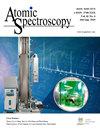First Location And Characterization Of Lunar Highland Clasts In Chang’E-5 Breccias Using TIMA-SEM-EPMA
IF 2.3
2区 化学
Q1 SPECTROSCOPY
引用次数: 5
Abstract
In this study, we identify for the first time four lunar highland clasts from the breccias (CE5C0800YJYX132GP) returned by the Chang’E 5 (CE-5) mission by combining Tescan Integrated Mineral Analysis (TIMA), Scanning Electron Microscopy (SEM), and Electron Probe Microanalysis (EPMA) techniques. The chemical compositions of plagioclases (An93.9–97.6) and mafic minerals (Fo71.4–87.9 for olivine and Mg65.1–84.6 for pyroxene) in these clasts are remarkably distinct from the more abundant mare basalts in the CE-5 landing site. They are in noritic anorthositic, troctolitic anorthositic, and troctolitic anorthositic compositions, which represent lunar highland crustal materials. Additionally, the three anorthositic clasts in the CE-5 samples are more magnesian than the Apollo ferroan anorthosites (FANs), but are similar to the magnesian anorthosites (MANs) commonly found in lunar highland meteorites. These newly found MANs in the CE-5 breccia are among the few reported in lunar returned samples, and may represent an important component of the lunar highland crust. Placing MANs in the rock lithologies of lunar feldspathic crust require a more complex crust-mantle process than that predicted by the classic Lunar Magma Ocean (LMO) hypothesis. Therefore, future research and characterization of Mg-suite and magnesian anorthositic rocks in CE-5 samples may help elucidate early lunar crustal evolution and crustmantle interaction.TIMA-SEM-EPMA首次定位和表征嫦娥五角砾岩中的月球高地碎屑
在本研究中,我们结合Tescan综合矿物分析(TIMA)、扫描电子显微镜(SEM)和电子探针微分析(EPMA)技术,首次从嫦娥五号(CE-5)任务返回的角砾岩(CE5C0800YJYX132GP)中鉴定了四个月球高地碎屑。这些碎屑中斜长石(An93.9–97.6)和镁铁质矿物(橄榄石为Fo71.4–87.9,辉石为Mg65.1–84.6)的化学成分与CE-5着陆点中更丰富的母质玄武岩明显不同。它们具有代表月球高地地壳物质的北欧斜长岩、三方斜长岩和三方斜长岩成分。此外,CE-5样品中的三种斜长岩碎屑比阿波罗铁质斜长岩(FANs)更具镁质,但与月球高地陨石中常见的镁质斜长石(MANs)相似。这些在CE-5角砾岩中新发现的MANs是月球返回样本中为数不多的报告之一,可能代表了月球高地地壳的重要组成部分。在月球长石地壳的岩石岩性中放置MANs需要比经典的月球岩浆洋(LMO)假说预测的更复杂的壳幔过程。因此,未来对CE-5样品中镁套和镁质斜长岩的研究和表征可能有助于阐明早期月球地壳演化和壳幔相互作用。
本文章由计算机程序翻译,如有差异,请以英文原文为准。
求助全文
约1分钟内获得全文
求助全文
来源期刊

Atomic Spectroscopy
物理-光谱学
CiteScore
5.30
自引率
14.70%
发文量
42
审稿时长
4.5 months
期刊介绍:
The ATOMIC SPECTROSCOPY is a peer-reviewed international journal started in 1962 by Dr. Walter Slavin and now is published by Atomic Spectroscopy Press Limited (ASPL). It is intended for the rapid publication of both original articles and review articles in the fields of AAS, AFS, ICP-OES, ICP-MS, GD-MS, TIMS, SIMS, AMS, LIBS, XRF and related techniques. Manuscripts dealing with (i) instrumentation & fundamentals, (ii) methodology development & applications, and (iii) standard reference materials (SRMs) development can be submitted for publication.
 求助内容:
求助内容: 应助结果提醒方式:
应助结果提醒方式:


